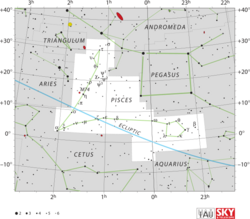Astronomy:Nu Piscium
| Observation data Equinox J2000.0]] (ICRS) | |
|---|---|
| Constellation | Pisces |
| Right ascension | 01h 41m 25.89391s[1] |
| Declination | +05° 29′ 15.4062″[1] |
| Apparent magnitude (V) | 4.44[2] |
| Characteristics | |
| Spectral type | K3 IIIb[2] |
| B−V color index | 1.37[2] |
| Astrometry | |
| Radial velocity (Rv) | +0.76[2] km/s |
| Proper motion (μ) | RA: −23.36[1] mas/yr Dec.: +3.36[1] mas/yr |
| Parallax (π) | 8.98 ± 0.23[1] mas |
| Distance | 363 ± 9 ly (111 ± 3 pc) |
| Absolute magnitude (MV) | −0.78[3] |
| Details | |
| ν Psc A | |
| Mass | 1.66[2] M☉ |
| Radius | 34±3[4] R☉ |
| Luminosity | 380[2] L☉ |
| Surface gravity (log g) | 1.91[5] cgs |
| Temperature | 4,154±23[2] K |
| Metallicity [Fe/H] | −0.16[5] dex |
| Age | 3.41[2] Gyr |
| Other designations | |
| Database references | |
| SIMBAD | data |
Nu Piscium (ν Piscium) is an orange-hued binary star[7] system in the zodiac constellation of Pisces. Prior to the formation of the modern constellation boundaries in 1930, it was designated 51 Ceti in the Cetus constellation.[8] Nu Piscium is visible to the naked eye, having a combined apparent visual magnitude of 4.44.[2] Based upon an annual parallax shift of 8.98 mas as seen from Earth,[1] it is located about 363 light years from the Sun.
The primary, component A, is an evolved, K-type giant star with a stellar classification of K3 IIIb.[2] It is a weak barium star, indicating that the atmosphere was previously enriched by accretion of s-process elements from what is now a white dwarf companion.[9] The giant has 1.66[2] times the mass of the Sun and has expanded to about 34[4] times the Sun's radius. It is about 3.4[2] billion years old and is radiating 380[2] times the Sun's luminosity from its photosphere at an effective temperature of 4,154 K.[2]
Naming
In Chinese, 外屏 (Wài Píng), meaning Outer Fence, refers to an asterism consisting of ν Piscium, δ Piscium, ε Piscium, ζ Piscium, μ Piscium, ξ Piscium and α Piscium. Consequently, the Chinese name for ν Piscium itself is 外屏五 (Wài Píng wu, English: the Fifth Star of Outer Fence.)[10]
References
- ↑ 1.0 1.1 1.2 1.3 1.4 1.5 van Leeuwen, F. (2007), "Validation of the new Hipparcos reduction", Astronomy and Astrophysics 474 (2): 653–664, doi:10.1051/0004-6361:20078357, Bibcode: 2007A&A...474..653V.
- ↑ 2.00 2.01 2.02 2.03 2.04 2.05 2.06 2.07 2.08 2.09 2.10 2.11 2.12 2.13 Luck, R. Earle (September 2015), "Abundances in the Local Region. I. G and K Giants", The Astronomical Journal 150 (3): 23, doi:10.1088/0004-6256/150/3/88, 88, Bibcode: 2015AJ....150...88L.
- ↑ Anderson, E.; Francis, Ch. (2012), "XHIP: An extended hipparcos compilation", Astronomy Letters 38 (5): 331, doi:10.1134/S1063773712050015, Bibcode: 2012AstL...38..331A.
- ↑ 4.0 4.1 Nordgren, Tyler E. et al. (December 1999), "Stellar Angular Diameters of Late-Type Giants and Supergiants Measured with the Navy Prototype Optical Interferometer", The Astronomical Journal 118 (6): 3032–3038, doi:10.1086/301114, Bibcode: 1999AJ....118.3032N, http://digitalcommons.wcupa.edu/cgi/viewcontent.cgi?article=1008&context=phys_facpub.
- ↑ 5.0 5.1 Prugniel, Ph.; Vauglin, I.; Koleva, M. (July 2011), "The atmospheric parameters and spectral interpolator for the MILES stars", Astronomy & Astrophysics 531: A165, doi:10.1051/0004-6361/201116769, Bibcode: 2011A&A...531A.165P.
- ↑ "nu. Psc". SIMBAD. Centre de données astronomiques de Strasbourg. http://simbad.u-strasbg.fr/simbad/sim-basic?Ident=nu.+Psc.
- ↑ McDonald, I. et al. (2012), "Fundamental Parameters and Infrared Excesses of Hipparcos Stars", Monthly Notices of the Royal Astronomical Society 427 (1): 343–57, doi:10.1111/j.1365-2966.2012.21873.x, Bibcode: 2012MNRAS.427..343M.
- ↑ Wagman, M. (August 1987), "Flamsteed's Missing Stars", Journal for the History of Astronomy 18 (3): 215, doi:10.1177/002182868701800305, Bibcode: 1987JHA....18..209W.
- ↑ Gomez, A. E. et al. (1997), "Absolute magnitudes and kinematics of barium stars", Astronomy and Astrophysics 319: 881, Bibcode: 1997A&A...319..881G.
- ↑ (in Chinese) AEEA (Activities of Exhibition and Education in Astronomy) 天文教育資訊網 2006 年 5 月 19 日
 |


